 |
||
|
||
| ||
Synthetic testsTestbed:
Our synthetic benchmarks:
Tested graphics cards:
We've selected these to compare with GeForce GTX 285 for the following reasons: GeForce GTX 280 is the direct predecessor, we use it to see performance difference produced by changed frequencies; RADEON HD 4850 X2 (and partially HD 4870 X2) are used, because they are the fastest High-End dual-GPU solutions from AMD, the cheaper of which competes with GTX 285 in price. Besides, this comparison may be interesting, because results of GTX 280 and HD 4870 X2 in synthetic tests were taken from our previous articles, where we used older drivers. That is, we can see how the latest drivers affect graphics card performance in synthetic tests. Direct3D 9: pixel filling testThis test determines peak texel rate in FFP mode for different numbers of textures applied to a pixel: 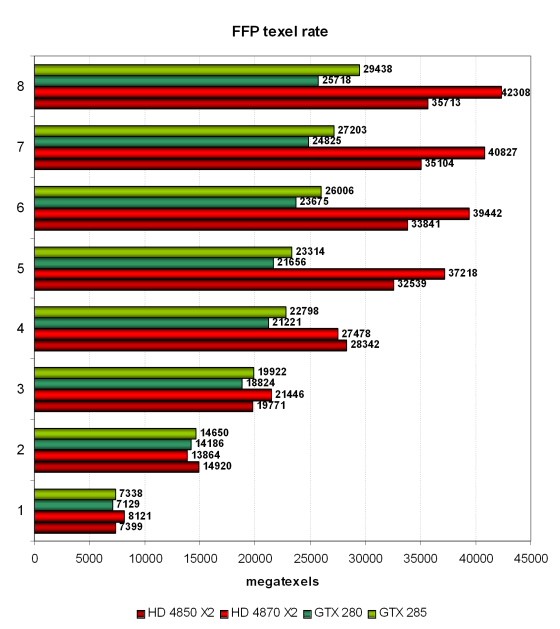 As usual, results of graphics cards fail to reach theoretical maximum. Graphics cards from previous generations got closer to this line, and new graphics cards with many TMUs cannot do it. Perhaps, our test restricts them. We can see that the speed of tests with 1-4 texture samples per pixel is limited by video memory bandwidth, and almost all cards perform on a par. In case of more textures per pixel, ROPs reveal their worth. In heavier conditions, dual-GPU cards from AMD shoot forward (AFR effectively doubles the frame rate in these tests). And differences between results of GTX 285 and GTX 280 conform with the theory. Let's have a look at the fill rate results: 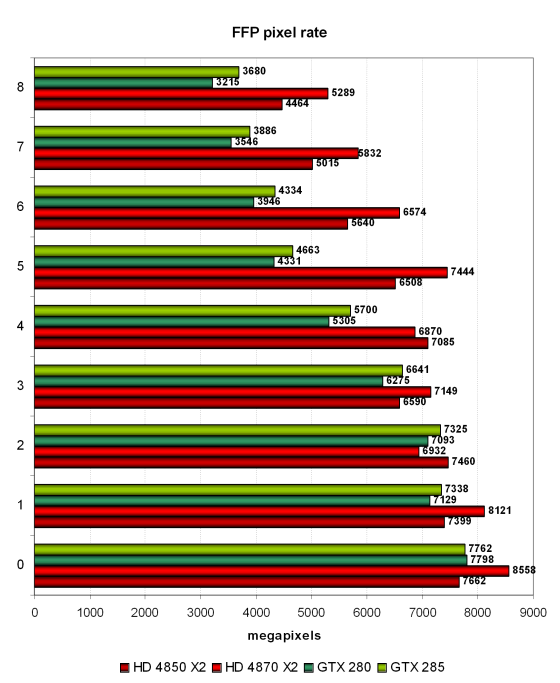 The second synthetic test measures the fill rate. It shows the same situation adjusted for the number of pixels written into the frame buffer. All our graphics cards again demonstrate similar results in tests with 0-3 textures, only HD 4870 X2 is a tad faster. And when performance is limited by the number and frequency of ROPs instead of memory bandwidth, dual-GPU cards get an apparent advantage. We can mention results of HD 4850 X2 with two and four textures. In these cases it even outperforms its more expensive "brother" probably owing to optimizations in the new driver. Direct3D 9: pixel shaders testThe first group of pixel shaders to be reviewed here is too simple for modern GPUs. It includes various versions of pixel programs of relatively low complexity: 1.1, 1.4, and 2.0. 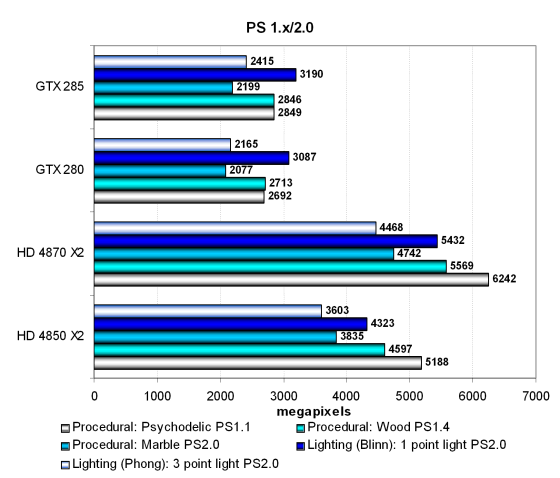 These tests are easy for modern architectures. They show texturing performance rather than arithmetics speed. As performance of simple tests is limited by the speed of texture sampling, dual-GPU solutions working in AFR mode get an advantage here and outscore single-GPU cards, including GeForce GTX 285. A similar ratio is demonstrated in more complex tests. GeForce GTX 285 shows good results, outscoring the previous top GT200 card by 6-12%, which conforms with theoretical data. But dual-GPU cards have an advantage, as GTX 280 failed to catch up even with GeForce 9800 GX2 in our old tests, to say nothing of HD 4850 X2. Let's have a look at results in more complex pixel programs of intermediate versions: 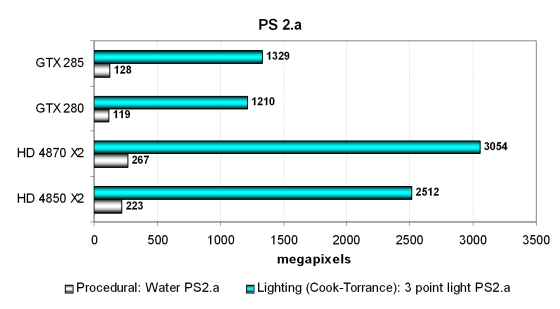 The procedural water test (which depends much on texturing performance) uses dependent texture lookups of high nesting depth, but the dual-GPU cards from AMD are more than twice as fast even here. After all, every RADEON used to be slower than solutions based on G92, G80, and GT200. The situation has changed to the contrary, now AMD cards are way ahead. GeForce GTX 285 again demonstrates results that comply with the theoretical values, outperforming GTX 280 by 8-10%. The second test (arithmetic-intensive) apparently favors the AMD architecture with more arithmetic units. NVIDIA cards, including GTX 285, are outperformed at least twofold in this test. That is even considering high efficiency of AFR in this test, RV770 apparently looks better than GT200 this time. Direct3D 9: new pixel shaders testsThese tests of DirectX 9 pixel shaders are even more complex, they are divided into two categories. We'll start with easier shaders - SM 2.0:
There are two modifications of these shaders: arithmetic intensive and texture sampling intensive. Let's analyze arithmetic-intensive modifications, they are more promising from the point of view of future applications: 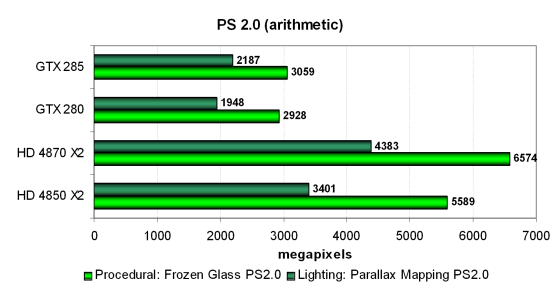 Results of our graphics cards in the Frozen Glass test do not differ much from results in the previous tests. These are arithmetic tests that mostly depend on the number and frequency of shader units, so GeForce GTX 280 and GTX 285 are outperformed by both cards from AMD. The new card from NVIDIA operating at slightly higher frequencies hasn't changed much here. It couldn't possibly do it. What concerns the second Parallax Mapping test, NVIDIA solutions are outscored by AMD cards even to a greater degree, up to twofold. And GTX 285 is just a tad faster than GTX 280, up to the difference in shader unit frequencies. Let's analyze results obtained in the texture sampling intensive tests, where the cards may perform differently, as NVIDIA chips used to cope with texturing better: 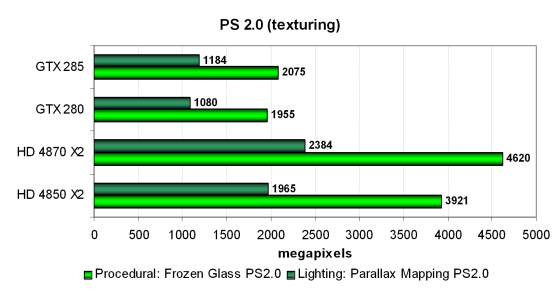 But now the layout of forces hasn't changed much, even though performance had been clearly limited by the speed of texture units. Modern architectures from AMD and NVIDIA graded up with each other, and RV770 does not suffer from low texturing speed anymore. So even though GeForce GTX 285 outperforms the older card from NVIDIA in both cases, it fails to catch up with dual-GPU products from AMD. Anyway, all solutions execute arithmetic-intensive shaders 1.5-2 times as fast as their modifications with lots of texture lookups. Let's have a look at results of another two pixel shader tests -- SM 3.0. They are the most complex of all our tests for Direct3D 9 pixel shaders. The tests load ALUs and texture units heavily. Both shader programs are complex, long, and include a lot of branches:
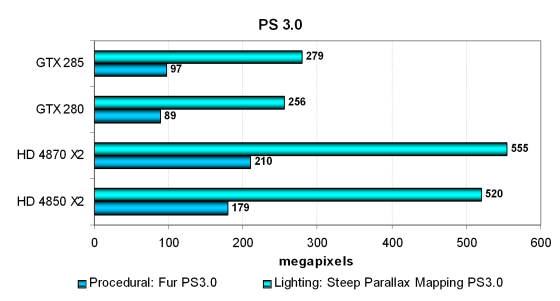 It's almost a complete repetition of the situation in previous tests. Dual-GPU solutions from AMD put up higher arithmetic performance, and they rapidly execute complex Pixel Shaders 3.0 with lots of branches. GeForce GTX 285 is outperformed by HD 4850 X2 by about 85%, although it's faster than GTX 280 by 9%, which is close to theoretical values. Write a comment below. No registration needed!
|
Platform · Video · Multimedia · Mobile · Other || About us & Privacy policy · Twitter · Facebook Copyright © Byrds Research & Publishing, Ltd., 1997–2011. All rights reserved. |